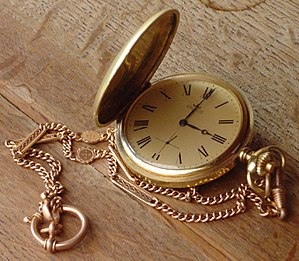時覺

時間知覺(粵拼:si4 gaan3 zi1 gok3;英文:time perception),簡稱時覺,指一個認知系統感受時間流逝嘅能力:由日常生活嘅觀察經已得知,人有能力感受時間嘅流逝,能夠一定程度上-但唔完全準確噉[1]-判斷一段時間嘅長度;噉就表示人腦(人心靈嘅所在)實係有某啲方法做計時嘅機制,所以人先會有能力對時間嘅長短作出判斷[2][3]。
有好多廿一世紀初嘅科學家都覺得,時間知覺同第啲感知功能比起上嚟零舍神秘:感知泛指心靈由外界嗰度接收資訊嘅認知過程,視覺同聽覺等都屬感知功能;但時間知覺就唔涉及對明確嘅物理刺激起反應-喺接收視覺資訊嗰陣,個心靈係感知緊光(一種電磁波);喺接收聽覺資訊嗰陣,個心靈係感知緊聲(介質粒子嘅振動);而嗅覺同味覺就係對化學成份嘅感知。但時間知覺就唔同,喺身體接收到嘅物理刺激當中,冇任何一種能夠直接攞嚟代表時間。噉即係話時間知覺涉及同第啲感知零舍唔同嘅認知過程[4][5]。
認知科學領域嘅研究者會有興趣研究時間知覺所涉及嘅認知功能。喺科研上,時間知覺相關實驗最簡單嘅做法係,將受試者擺喺實驗室入面,做各種嘅操作,然後要求受試者對「過咗幾耐時間」以及「某兩個刺激之間時間上差距幾遠」等嘅問題作出判斷,並且睇吓受試者嘅呢啲判斷會受乜因素影響或者同邊啲腦活動有統計相關。呢類實驗可以用嚟測試各種有關時間知覺嘅假說[4][6]。
基礎
[編輯]時覺定義上係「感受時間[註 1]流逝嘅感知功能」:感知係泛指「一個認知系統由外界攞資訊,從而得知外界有咩喺度」嘅認知功能-視覺涉及對眼感受外界嘅光、聽覺涉及對耳仔感受外界嘅聲(介質粒子嘅振動)、味覺涉及條脷上面嗰啲味蕾感受掂到嘅嘢嘅化學成份... 呀噉[7];由平時嘅日常觀察就可以得知,人有能力大致上噉對「兩件事件之間相隔咗幾耐時間」作出判斷,噉即係話人腦實係有某啲方法感受時間嘅流逝,人先至有可能做到呢啲噉嘅判斷[1][2]。
時覺實驗
[編輯]响廿一世紀初嘅認知心理學上,研究時覺最常用嘅方法係心理實驗,以「受試者對時間長度嘅判斷」做被影響嘅變數:研究者會搵若干位受試者返去實驗室嗰度,要求佢哋放低智能手機或者手錶等嘅計時架生,直至實驗結束為止都唔准佢哋睇呢啲架生-噉做用意係想受試者焗住要齋靠自己嘅腦嚟計時;跟住研究者會一路私底下計住時,過咗一段時間後佢哋就會問受試者,要求受試者對「過咗幾耐時間」作出判斷,即係例如叫受試者嘗試講出「過咗幾多秒」[8]。
時覺實驗仲有好多進階版本。首先時覺實驗可以分做兩大種[9][10]-
- 一種係受試者事前就知道研究者會問佢判斷時間長度(prospective timing);
- 另一種係受試者事前唔知研究者會問佢判斷時間長度(retrospective timing);
而且時覺實驗仲可以涉及比較時間長度,即係研究者特登施加兩吓刺激,例如先後噉播兩吓聲俾受試者聽,兩吓聲時間長度唔同(研究者暗中知嗰兩吓聲分別係幾長),再要求受試者判斷兩吓聲「分別有幾長」或者「邊吓聲長啲」。有咗呢啲研究方法,心理學家同神經科學家就可以郁手研究時覺-研究者可以做各種嘅實驗操作,睇吓呢啲操作會點樣影響受試者對時間長度嘅判斷,靠噉嚟測試有關時覺嘅假說,例如係用神經造影技術監察住受試者嘅腦活動,睇吓邊啲腦區嘅活動同「响腦入面計時」有關[8]。

認知相關
[編輯]錯覺
[編輯]時錯覺(temporal illusion)係指時覺上出現嘅錯覺-即係某啲會扭曲人嘅時覺嘅嘢。
註釋
[編輯]神經相關
[編輯]睇埋
[編輯]文獻
[編輯]- Grondin, S. (2010). Timing and time perception: A review of recent behavioral and neuroscience findings and theoretical directions (PDF). Attention, Perception, & Psychophysics, 72(3), 561-582.
- Le Poidevin R (Winter 2004). Zalta EN (ed.). "The Experience and Perception of Time". The Stanford Encyclopedia of Philosophy.
- Matthews, W. J., & Meck, W. H. (2016). Temporal cognition: connecting subjective time to perception, attention, and memory (PDF). Psychological bulletin, 142(8), 865.
引咗
[編輯]- ↑ 1.0 1.1 Livni E (8 January 2019). "Physics explains why time passes faster as you age". Quartz.
- ↑ 2.0 2.1 Evans V (2013). Language and time: a cognitive linguistics approach. Cambridge: Cambridge University Press.
- ↑ Pöppel, E. (1978). Time perception. In Perception (pp. 713-729). Springer, Berlin, Heidelberg.
- ↑ 4.0 4.1 How the Brain Creates a Timeline of the Past. Quanta Magazine.
- ↑ Allan, L. G. (1979). The perception of time. Perception & Psychophysics, 26(5), 340-354.
- ↑ Antonides, G., Verhoef, P. C., & Van Aalst, M. (2002). Consumer perception and evaluation of waiting time: A field experiment. Journal of consumer psychology, 12(3), 193-202.
- ↑ Takahashi, T., Oono, H., & Radford, M. H. (2008). Psychophysics of time perception and intertemporal choice models. Physica A: Statistical Mechanics and its Applications, 387(8-9), 2066-2074.
- ↑ 8.0 8.1 Grondin, S. (2010). Timing and time perception: A review of recent behavioral and neuroscience findings and theoretical directions (PDF). Attention, Perception, & Psychophysics, 72(3), 561-582.
- ↑ Brown, S. W., & Stubbs, D. A. (1988). The psychophysics of retrospective and prospective timing. Perception, 17(3), 297-310.
- ↑ Hicks, R. E., Miller, G. W., & Kinsbourne, M. (1976). Prospective and retrospective judgments of time as a function of amount of information processed. The American journal of psychology, 719-730.
- ↑ Keele, S. W., & Ivry, R. (1990). Does the Cerebellum Provide a Common Computation for Diverse Tasks? A Timing Hypothesis a. Annals of the New York Academy of Sciences, 608(1), 179-211.
- ↑ Ivry, R. B., Keele, S. W., & Diener, H. C. (1988). Dissociation of the lateral and medial cerebellum in movement timing and movement execution. Experimental brain research, 73(1), 167-180.
- ↑ Pouthas, V., George, N., Poline, J. B., Pfeuty, M., VandeMoorteele, P. F., Hugueville, L., ... & Renault, B. (2005). Neural network involved in time perception: an fMRI study comparing long and short interval estimation. Human brain mapping, 25(4), 433-441.
- ↑ Danckert, J., Ferber, S., Pun, C., Broderick, C., Striemer, C., Rock, S., & Stewart, D. (2007). Neglected time: impaired temporal perception of multisecond intervals in unilateral neglect. Journal of cognitive neuroscience, 19(10), 1706-1720.
- ↑ Alexander, I., Cowey, A., & Walsh, V. (2005). The right parietal cortex and time perception: back to Critchley and the Zeitraffer phenomenon. Cognitive Neuropsychology, 22(3-4), 306-315.
- ↑ Harrington, D. L., & Haaland, K. Y. (1999). Neural underpinnings of temporal processing: Α review of focal lesion, pharmacological, and functional imaging research. Reviews in the Neurosciences, 10(2), 91-116.
